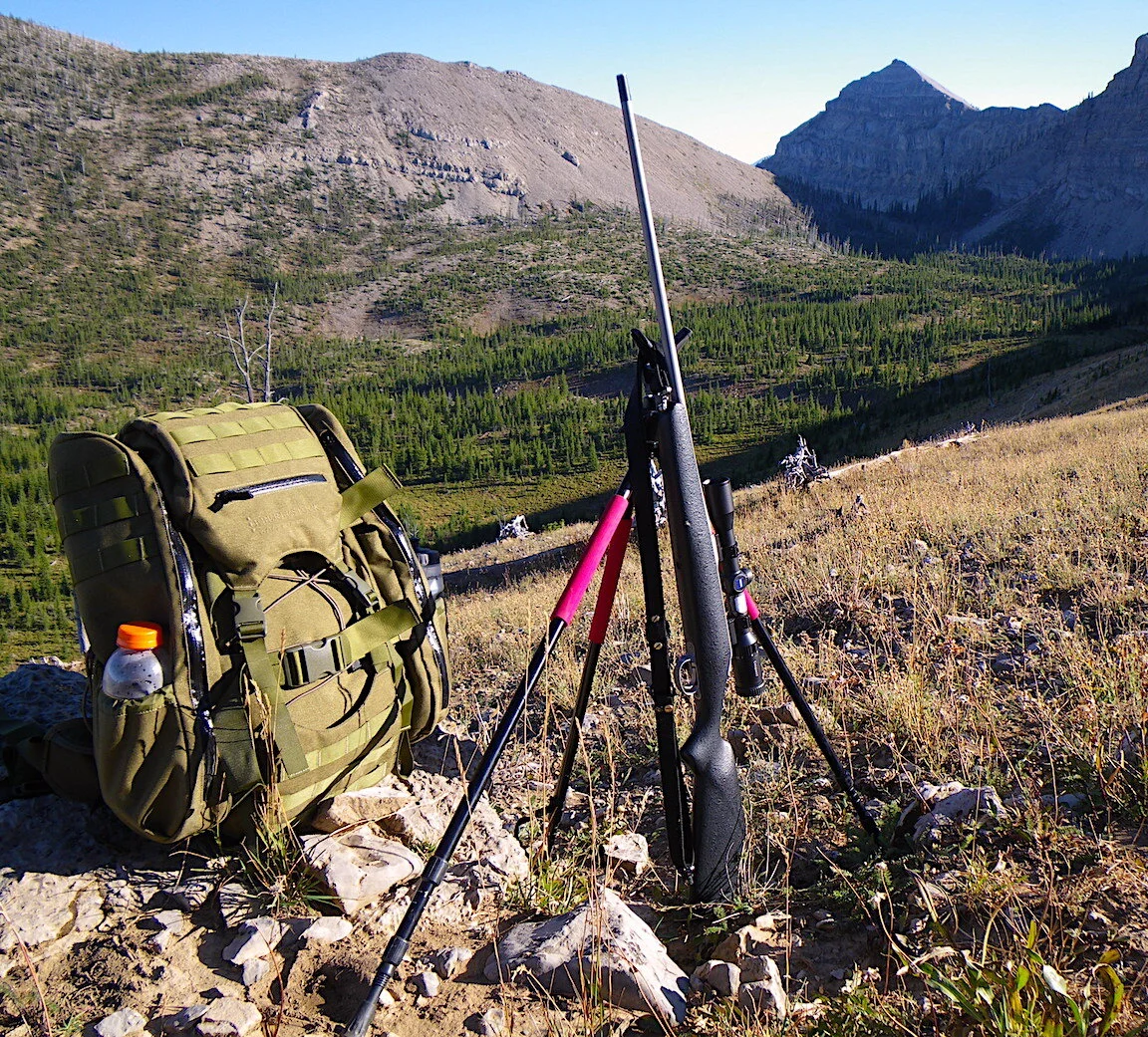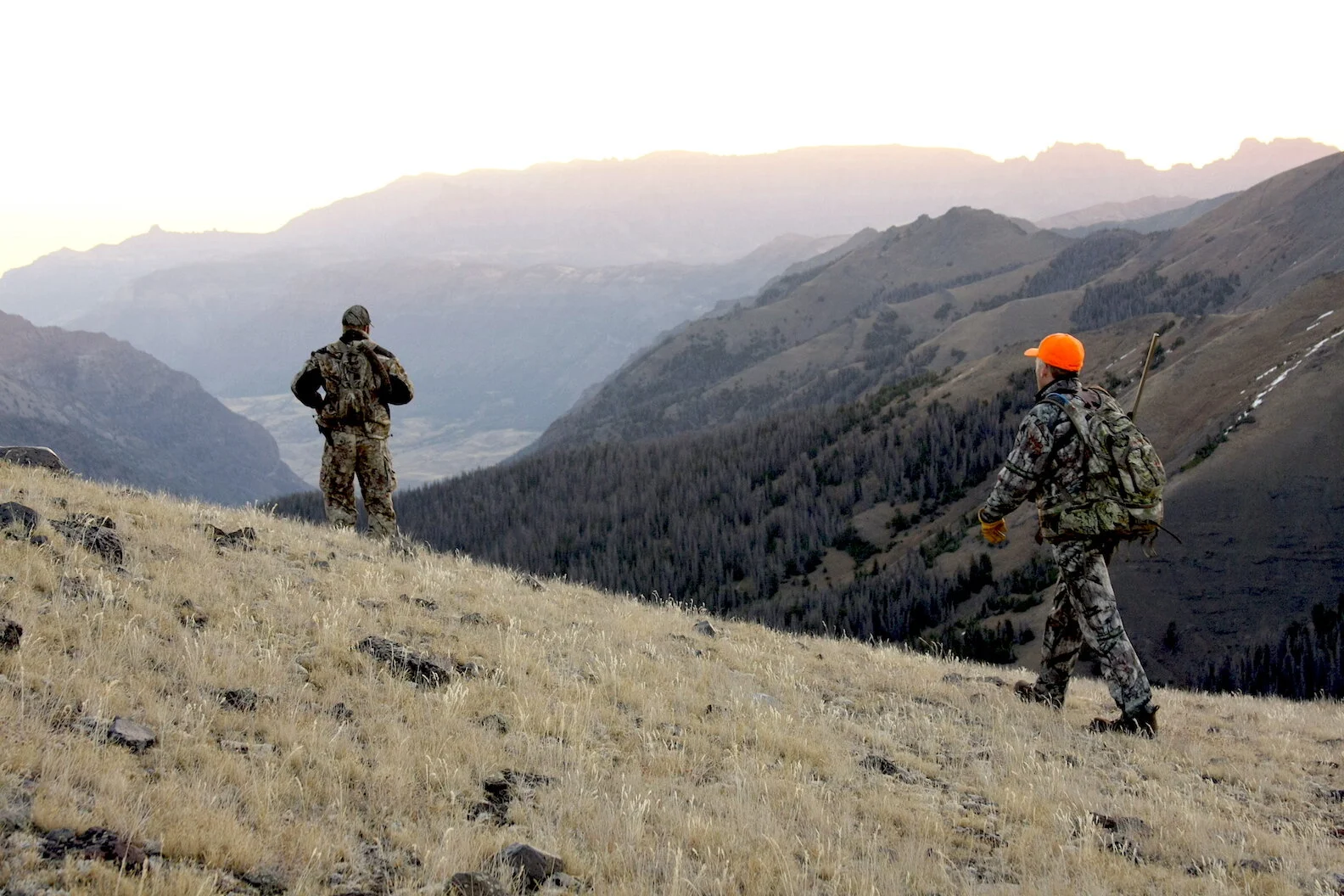Field Rests
This article first appeared in Gun Hunter magazine.
Yeah, you can call "shooting sticks" crutches. Heck, call those of us who use them sissies. We don't care because hunting is not a contest to determine who is the best offhand shot. When you have an animal in your sights, you owe it to yourself and that animal to place your shot as precisely as possible, and that's rarely done from an unsupported, standing position. Put another way, why risk to a wobbly gun what might be the only shot of your season, the only B&C buck of your life? Smart hunters use field rests. But which rest is best?
Field supports come in three basic forms: monopods, bipods and tripods. Some are carried attached to the firearm, some snap on to a small mount that's fixed to the gun, and some are carried and propped up before each shot. The one that'll work best for you depends on terrain (flat, hilly, mountainous,) habitat (short grass, knee-high brush, thick forest) and your style of hunting (still-hunting, glass/stalk, stand.) Let's examine these tools more closely. This isn't an exhaustive list, but a solid overview of what's out there. Search and you may find something newer, better or less expensive.
MONOPOD
A single leg provides good vertical stabilization, but marginal lateral stabilization. Monos tend to sway side-to-side, especially in wind or if you're breathing hard. Most monopods are designed for standing or sitting shots. Many telescope from sitting height to standing and double as hiking staffs, a surprisingly useful device for maintaining balance and minimizing fatigue, especially in mountainous terrain. Reasonably light and versatile, monopods are a good option if you walk a lot and may have to shoot quickly offhand. Combined with natural objects like boulders, cutbanks, and your own legs, they can be stabilized against excessive lateral wobble. Jam the foot into the ground, press the upper third of the shaft against a boulder and you'll tame most lateral movement. Hold the leg against your own bent leg/knee while sitting. Prop it against a pack. Experiment with any monopod to discover optimum stability. Then practice in these positions so they become second nature.
Many shooters like to angle the stick in or out from the line of the barrel, pushing or pulling against it to create almost a gyroscopic effect for beating side-by-side wobble. Pressing your rifle stock against the side of the pole, instead of balancing it atop, can also settle things down. Some bipods and tripods can be closed and carried like a monopod for similar benefits, but they're always heavier. Adjusting length on telescoping monopods involves twisting leg sections (usually two or three) or opening and closing a clamp of some sort. The unique Primos Trigger Stick adjusts just by squeezing the handle. Many monopods, like the Stoney Point Polecat, include a 1/4-20 and/or 3/8-16 bolt on top to accommodate cameras and spotting scopes as well as rifle yokes. Some yokes swivel, others are fixed. The Shooters Ridge Stalk Stick's V-rest stores in the grip handle and pops up for use. Most monopods include rubber or foam grips and a wrist strap.
BIPOD
Two-legged supports are popular with precision shooters because they stabilize lateral and vertical motion, yet set up nearly as quickly as monopods -- and don't weigh much more. In fact, some skinny bipods weigh considerably less. Bipods are generally limited to an adjustment range within three categories: prone, sitting / kneeling, and standing. Some sitting versions can convert upward or downward, but rarely both. One of the oldest and most popular bipods is the Harris. This rugged unit (several models) screws snuggly to the fore-end sling stud. Its legs fold forward along the barrel. To deploy, reach up and pull each back until it snaps into place. Legs can be pulled out to change height and locked fully extended or at any intermediate length with a setscrew. Press a button and the lower leg snaps back inside the upper.
Shooter's Ridge bipods look and perform much like Harris units but are made in China. External springs make both brands something less than elegant, but rugged and durable. B-Square bipods have no external springs, are sleeker, lighter but perhaps not as rugged, though I haven't conducted any tests. The B-Square Roto-Tilt head pans and tilts for scope leveling on broken ground. Harris and Shooter's Ridge offer pivoting heads, too. Attached, prone bipods are nearly as steady as sandbags on a benchrest and absolutely deadly. Their biggest drawback is Mother Earth. She doesn't always accommodate prone shooting. Rocks get in the way. Shrubs block the view. Grasses cover the sights. Even a gentle tilt of the landscape can obscure your target when you place your muzzle just a few inches off the ground. When conditions are perfect, so is a prone bipod. When they aren't, the prone bipod becomes more hindrance than help.
Don't believe it? Hike typical hunting terrain and hit the ground to set up for a shot at odd times. Don't wait until you're in a freshly mown alfalfa field flatter than today's stock market. Do it on a creek side slope, in a rocky pasture, at the base of a steep hill while aiming up. Yeow! Doesn't work so well, does it? One solution is a sitting-length bipod. Harris and Shooters Ridge come in sitting lengths. B-Square sells extension legs that push the 13-inch maximum length to 20-inches. Longer legs add bulk and weight, of course. Any affixed bipod will unbalance a rifle and impede one's ability to swing, get into action quickly and otherwise handle a rifle in a hurry. The Versa-Pod minimizes the balance issue by popping on and off a base secured to the swivel stud. It too has spring-loaded legs, tilt and pan head options. Stoney Point's Rapid Pivot Bipod legs easily and quietly snap off and onto a small swivel-mounted stud. Bog-pod's aluminum bipod legs adjust from 22" to 68" (sitting to standing) with a twist and pull of each leg section. The V-rest swivels 360 degrees smoothly and easily. The lightest detachable bi-pod I know is the Kramer Snipe-Pod, a pair of jointed, shock-corded aluminum shafts that snap onto a small base affixed to the rifle's stud. Each leg fits via ball socket into the head that clips onto the base unit, thus each moves in any direction for panning, tilting and canting. Weight is 3 ounces prone, 6 ounces sitting. The leg unit can be carried fully extended in the hand, folded back along the stock or broken down to less than 8-inches and worn in a belt pouch. Steady Stix are the original jointed, shock corded, tent-pole supports. Extremely light and thin, Steady Stix can be carried in hand or folded in a belt pouch. They whip into action quickly, spread to a variety of heights and can even be taken down to prone size by disjointing sections. It's easy to swing a rifle up, down and sideways in a Stix.
Their only drawbacks are: 1. Sections popping apart if the tips are gripped by mud or snow. 2. Falling over or jumping up and spreading wide after recoil. Second shots are not fast with this device. The unjointed Predator Sniper Styx weigh 6 ounces and appear to have thicker walls than my Steady Stix. They're topped with caps of a coarse rubber designed to grip rifle stocks. Ends are fitted with threaded inserts that accept screw-in archery points. Extension rods let you customize to standing height.The H-S Johnny Stewart Quik-Shot is a simple pair of oak slats joined near the top with a brass bolt and rubber washer and capped with rubber hose for a gun grip. Simple, fast, effective, 9 ounces and quiet.If you're pinching pennies, build a bipod out of a couple of oak dowels, narrow pipes or anything similar. Attach them near the top with a through bolt. Or just wrap an old inner tube around them and tie into place.
TRIPOD
Three legs are steadier than one. But they are heavier and take longer to set up, too. Nonetheless, tripods are a viable field support and quite versatile. The first I ever used was the Bog-pod about two years ago. I wasn't thrilled initially, but the more I used it the more I liked it. While not as light and quick to deploy as my Shooting Stix, Predator Styx, or Snipe Pod, the tripod proved steadier and more versatile. I eventually used it to make a couple of 450-yard shots. And then dozens of long shots around the world. If you hike, spot-stalk, glass with a spotting scope or photograph (telephotos, self-timer shots), a tripod is the way to go. Shorten one leg and use the other two like a bipod. Fasten all legs together with Velcro and you've got a passable hiking staff. The grip is a bit bulky, but the Bog-pod rubber grips provide traction and insulation from the cold metal. With all legs extended (from 22-68-inches) this tripod provides amazing stability for precise shots. The V-yoke spins 360-degrees, but it can be popped off and replaced with a Switcheroo ball head with quick release plates that accommodate cameras, scopes and binoculars. Stoney Point builds a tripod by adding a clamp-on leg to its bipod. There's even a rear support arm that can be attached to one leg and telescope up to the butt of your rifle for additional support.
This isn't something you'll whip into action quickly, but if you've got the time… The Shooter's Ridge Tri-Leg Sticks are the lightest tripod I've yet found. It's basically the shock-corded, jointed bipod sticks with a third leg added. Light, simple, effective. Similarly, Stoney Point sells a "third leg" kit that converts its bipod into a tripod, too. Heavier is the Stoney Point Rapid Pivot Tripod that, like its two-legged cousin, snaps onto a mount affixed to the fore-end swivel stud for 360-degree rotation. I question whether this mount permits much up and down tilting of the muzzle. Check it out. African Shooting Sticks from Sporting Wood are jointed with a machined aluminum mid-section that uses a rubber gasket to lock each leg half. No wobble, no noise. Solid, heavy and durable enough for a lifetime. These full length tripods have long been favored by African Professional Hunters and work just as well in the U.S. where standing shots are most common. With the bottom leg removed, African Shooting Sticks are a perfect height for sitting and kneeling. Extremely durable. There are other brands and variations of field supports on the market, but these are the major categories and styles. Before you buy, try as many as possible. If you can't take them afield, at least go through the motions in the store. Borrow a rifle and see if various supports set up quickly, allow you to shift position and aim the rifle up and down at steep angles, etc. Then get one or more and dedicate yourself to practicing and hunting with them. I'm betting you'll become a much more confident and effective shot. Popular brands:
Tips & Suggestions:
Tripods won't set up as quickly as bipods, but can be steadier.
Pan, tilt and swivel heads accommodate moving game and odd shooting angles, but may not stabilize a rifle as well as a fixed head.
Choose heavier, slower to deploy, but steadier supports for stand hunting, varmint shooting, extreme-range shooting.
Choose lighter, faster to deploy supports for active hunting or broken terrain.
Shock corded bipod legs often come apart if the foot sticks in mud or snow.
Hand held, spreadable sticks must be set fairly wide to fit the stock in the upper V.
Spread sticks often fall away after recoil.





